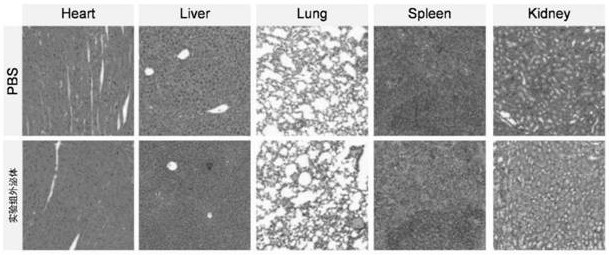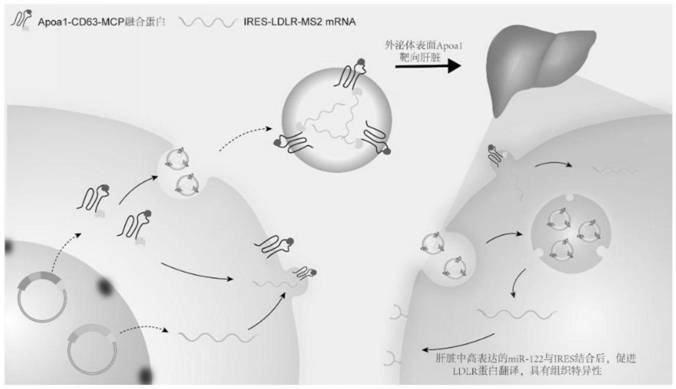Recombinant gene set for collaborative liver targeting delivery of low density lipoprotein receptor (LDLR),vector group, exosome, construction method and application
A technology of recombinant genes and construction methods, applied in the field of genetic engineering, can solve the problems of off-target, lack of effective means, weak targeting ability of exosomes, etc., to promote protein translation, treat hyperlipidemia, and increase liver targeting. Effect
- Summary
- Abstract
- Description
- Claims
- Application Information
AI Technical Summary
Problems solved by technology
Method used
Image
Examples
preparation example Construction
[0043]The preparation method of the exosome of the present invention is simple and easy.
[0044] The present invention loads Apoa1 protein on the surface of exosomes by means of genetic engineering, and the modified exosomes can target the liver; uses RNA binding protein to bind target RNA, assists RNA to enter exosomes, efficiently loads target RNA, and the modified exosomes Secretosomes, as a means of intercellular protein and nucleic acid information molecule transmission, can effectively achieve the purpose of interfering with endogenous proteins; when miR-122, which is highly expressed in the liver, binds to IRES, its conformation changes and protein translation is promoted. Inserting the IRES element into the 5' end of LDLR mRNA can realize the tissue specificity of nucleic acid drugs carried in exosomes. After the above modifications, an engineered exosome that targets the liver and efficiently loads hepatocyte-responsive mRNA can be produced, which has ideal targeting...
Embodiment 1
[0048] according to Figure 4 (Schematic diagram of the hypothesis) to conduct the experiment:
[0049] Construction of the recombinant expression vector set: the recombinant expression vector set was completed by GenScript Biotechnology Company;
[0050] (1) The first recombinant expression vector: Pme1 and BstBI are selected as restriction sites;
[0051] (2) From the 5' end to the 3' end, the IRES fragment (as shown in SEQ ID No.3), the LDLR (human9) fragment (as shown in SEQ ID No.5) and the MS2 fragment (as shown in SEQ ID No. .5) to obtain the first recombinant gene, the nucleotide sequence is as shown in SEQ ID No.1 in the sequence listing;
[0052] (3) The second recombinant expression vector: Pme1 and BstBI are selected as restriction sites;
[0053] (4) From the 5' end to the 3' end, the kozak fragment (as shown in SEQ ID No.6), the first CD63 fragment (as shown in SEQ ID No.7), and the Apoa1 fragment (as shown in SEQ ID No. 8), CD63 second fragment (as shown in ...
Embodiment 2
[0057] The obtained exosomes were subjected to qPCR to detect the level of LDLR mRNA in exosomes. For the experimental steps, refer to "In Vitro and in Vivo RNA Inhibition by CD9-HuR Functionalized Exosomes Encapsulated with miRNA or CRISPR / dCas9" (PMID: 30517011). The result is as image 3 As shown, compared with the control group, Exo IRES -LDLR-MS2+Kozak-CD63-Apoa1-CD63-MCP The level of LDLR mRNA was significantly increased.
PUM
 Login to View More
Login to View More Abstract
Description
Claims
Application Information
 Login to View More
Login to View More - Generate Ideas
- Intellectual Property
- Life Sciences
- Materials
- Tech Scout
- Unparalleled Data Quality
- Higher Quality Content
- 60% Fewer Hallucinations
Browse by: Latest US Patents, China's latest patents, Technical Efficacy Thesaurus, Application Domain, Technology Topic, Popular Technical Reports.
© 2025 PatSnap. All rights reserved.Legal|Privacy policy|Modern Slavery Act Transparency Statement|Sitemap|About US| Contact US: help@patsnap.com



